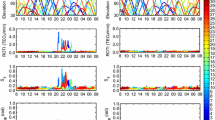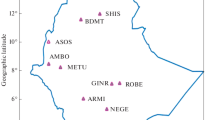Abstract
The rate of change of total electron content (TEC) index (ROTI), an important parameter to characterize ionospheric irregularities and associated scintillation activities, can be calculated from both new Global Positioning System (GPS) civilian L2C and legacy GPS L2 P(Y) signals. We investigate the inconsistency of the ROTI indices derived from L2C, denoted as ROTIL2C, and from L2 P(Y), denoted as ROTIL2P, through the analysis of 3 months of GPS data collected by four types of GNSS receivers, i.e., Javad, Leica, Septentrio, and Trimble, installed at five low-latitude stations. The results show that inconsistencies existing between the ROTIL2C and ROTIL2P may be related to the receiver configurations, such as tracking techniques. For both Leica and Trimble receivers, ROTIL2C and ROTIL2P are generally comparable; for the Septentrio receiver, ROTIL2C is larger than ROTIL2P by 0.5–1.1 TECu/min; for the Javad receiver, ROTIL2C is smaller than ROTIL2P by 0.3–0.5 TECu/min. A significant inconsistency of ROTIL2C (also ROTIL2P) is also found from the cross-comparison between receivers deployed at zero/short baselines. In addition, we find that large discrepancy of ROTI is observed for satellites with low maximum elevation angle. The correlation coefficients between ROTIL2C and S 4 are on average in the range of 0.4–0.8, comparable to those of ROTIL2P with S 4. But, a low correlation coefficient is found for satellites with low maximum elevation angle. The ratios between ROTIL2C and S 4 are also calculated. They are in the range of 3–9, larger than those between ROTIL2P and S 4. This study suggests that cautions be taken when the ROTI index, either ROTIL2P or ROTIL2C, derived from different types of GNSS receivers is used to characterize ionospheric irregularities and associated scintillations.















Similar content being viewed by others

References
Al-Fanek O, Skone S, Lachapelle G, Fenton P (2007) Evaluation of L2C observations and limitations. In: Proceedings of ION GNSS 2007, Institute of Navigation Fort Worth, Texas, 25–28 September, pp 2510–2518
Basu S, Groves K, Quinn J, Doherty P (1999) A comparison of TEC fluctuations and scintillations at Ascension Island. J Atmos Solar Terr Phys 61(16):1219–1226
Beach TL, Kintner PM (1999) Simultaneous global positioning system observations of equatorial scintillations and total electron content fluctuations. J Geophys Res: Sp Phys 104(A10):22553–22565
Cherniak I, Zakharenkova I, Krankowski A (2014) Approaches for modeling ionosphere irregularities based on the TEC rate index. Earth, Planets Sp 66(1):1–5. doi:10.1186/s40623-014-0165-z
Engel U (2008) A theoretical performance analysis of the modernized GPS signals. In: Position, location and navigation symposium, 2008 IEEE/ION, Monterey, 5–8 May 2008, pp 1067–1078
Fontana RD, Cheung W, Stansell T (2001) The modernized L2 civil signal. GPS World 12(9):28–35
Hauschild A, Montenbruck O (2014) A study on the dependency of GNSS pseudorange biases on correlator spacing. GPS Solut 20(2):159–171. doi:10.1007/s10291-014-0426-0
Humphreys T, Young L, Pany T (2008) Considerations for future IGS receivers. In: IGS analysis center workshop, Miami Beach, 2–6 June 2008, pp 1–19
Krankowski A, Shagimuratov I, Baran L, Ephishov I, Tepenitzyna N (2006) The occurrence of polar cap patches in TEC fluctuations detected using GPS measurements in southern hemisphere. Adv Sp Res 38(11):2601–2609
Leandro RF, Thirumurthi T, Sukeova L, Langley RB, Santos MC (2008) Analysis of GPS L2C signal quality and its impact on PPP performance. In: Proceedings of ION NTM 2008, Institute of Navigation, San Diego, January 28–30, pp 1020–1031
Leick A, Rapoport L, Tatarnikov D (2015) GPS satellite surveying. Wiley, London. doi:10.1002/9781119018612
Leveson I (2006) Benefits of the new GPS civil signal. Inside GNSS 1(5):42–47
Li H, Lu M (2015) Double-chipwise correlation technique for efficient L2C signal acquisition. Aerosp Electr Syst, IEEE Trans 51(2):1575–1582
Liu Z (2011) A new automated cycle slip detection and repair method for a single dual-frequency GPS receiver. J Geodesy 85(3):171–183
Ma G, Maruyama T (2006) A super bubble detected by dense GPS network at east Asian longitudes. Geophys Res Lett. doi:10.1029/2006GL027512
Marques H, Monico J, Marques H (2015) Performance of the L2C civil GPS signal under various ionospheric scintillation effects. GPS Solut 20(2):139–149. doi:10.1007/s10291-015-0472-2
McDonald KD (2002) The modernization of GPS: plans, new capabilities and the future relationship to Galileo. J Glob Pos Syst 1(3):1–17
Montenbruck O, Hauschild A, Steigenberger P (2014a) Differential code bias estimation using multi-GNSS observations and global ionosphere maps. Navigation 61(3):191–201
Montenbruck O, Steigenberger P, Khachikyan R, Weber G, Langley R, Mervart L, Hugentobler U (2014b) IGS-MGEX: preparing the ground for multi-constellation GNSS science. Inside GNSS 9(1):42–49
Nishioka M, Saito A, Tsugawa T (2008) Occurrence characteristics of plasma bubble derived from global ground-based GPS receiver networks. J Geophys Res. doi:10.1029/2007JA012605
O’Keefe K, Wang D, Petovello MG, Gernot C (2009) Benefit of partial L2C availability for correcting ionospheric error for standalone GPS. In: Proceedings of ION GNSS 2009, Institute of Navigation, Savannah, September 22–25, pp 2530–2550
Oladipo O, Schüler T (2013) Equatorial ionospheric irregularities using GPS TEC derived index. J Atmos Solar Terr Phys 92:78–82
Pi X, Mannucci A, Lindqwister U, Ho C (1997) Monitoring of global ionospheric irregularities using the worldwide GPS network. Geophys Res Lett 24(18):2283–2286
Pi X, Mannucci AJ, Valant-Spaight B, Bar-Sever Y, Romans LJ, Skone S, Sparks L, Hall GM (2013) Observations of global and regional ionospheric irregularities and scintillation using GNSS tracking networks. In: Proceedings of ION 2013 Pacific PNT Meeting, Honolulu, Hawaii, April 23–25, pp 752–761
Rizos C, Montenbruck O, Weber R, Weber G (2013) The IGS MGEX experiment as a milestone for a comprehensive multi-GNSS service. In: Proceedings of ION 2013 Pacific PNT meeting, Honolulu, Hawaii, April 23–25, pp 289–295
Shanmugam S, Jones J, MacAulay A, Van Dierendonck A (2012) Evolution to modernized GNSS ionoshperic scintillation and TEC monitoring. In: Position location and navigation symposium, 2012 IEEE/ION, 23–26 April 2012, pp 265–273
Sokolovskiy S, Schreiner W, Zeng Z, Hunt D, Kuo Y-H, Meehan T, Stecheson T, Mannucci A, Ao C (2014) Use of the L2C signal for inversions of GPS radio occultation data in the neutral atmosphere. GPS Solut 18(3):405–416
Sükeová L, Santos MC, Langley RB, Leandro RF, Nnani O, Nievinski F (2007) GPS L2C signal quality analysis. In: Proceedings of the ION 63rd annual meeting, Cambridge, 23–25 April 2007, pp 23–25
Tiwari R, Strangeways H, Tiwari S, Ahmed A (2013) Investigation of ionospheric irregularities and scintillation using TEC at high latitude. Adv Sp Res 52(6):1111–1124
Tran M (2004) Performance evaluations of the new GPS L5 and L2 civil (L2C) signals. Navigation 51(3):199–212
Wang D, O’Keefe K (2010) Benefit of partial L2C availability to estimate ionospheric delay for dual-frequency GPS ambiguity resolution. In: Position location and navigation symposium, 2010 IEEE/ION, 2010, pp 44–52
Wang N, Yuan Y, Li Z, Montenbruck O, Tan B (2016) Determination of differential code biases with multi-GNSS observations. J Geodesy 90(3):209–228. doi:10.1007/s00190-015-0867-4
Yang Z, Liu Z (2015) Correlation between ROTI and ionospheric scintillation indices using Hong Kong low-latitude GPS data. GPS Solut. doi:10.1007/s10291-015-0492-y
Acknowledgments
The supports from the National Natural Science Foundation of China (Grant No. 41274039) are gratefully acknowledged. This work is supported by the Hong Kong Research Grants Council (RGC) projects (PolyU 5325/12E, F-PP0F and PolyU 5203/13E, B-Q37X) and PolyU project 4-BCBT and G-YBDA. We thank the International GNSS Service’s Crustal Dynamics Data Information System (CDDIS) for providing the MGEX data. The anonymous reviewers are thanked for providing constructive comments, which help improve the quality of this paper.
Author information
Authors and Affiliations
Corresponding author
Rights and permissions
About this article
Cite this article
Yang, Z., Liu, Z. Investigating the inconsistency of ionospheric ROTI indices derived from GPS modernized L2C and legacy L2 P(Y) signals at low-latitude regions. GPS Solut 21, 783–796 (2017). https://doi.org/10.1007/s10291-016-0568-3
Received:
Accepted:
Published:
Issue Date:
DOI: https://doi.org/10.1007/s10291-016-0568-3



